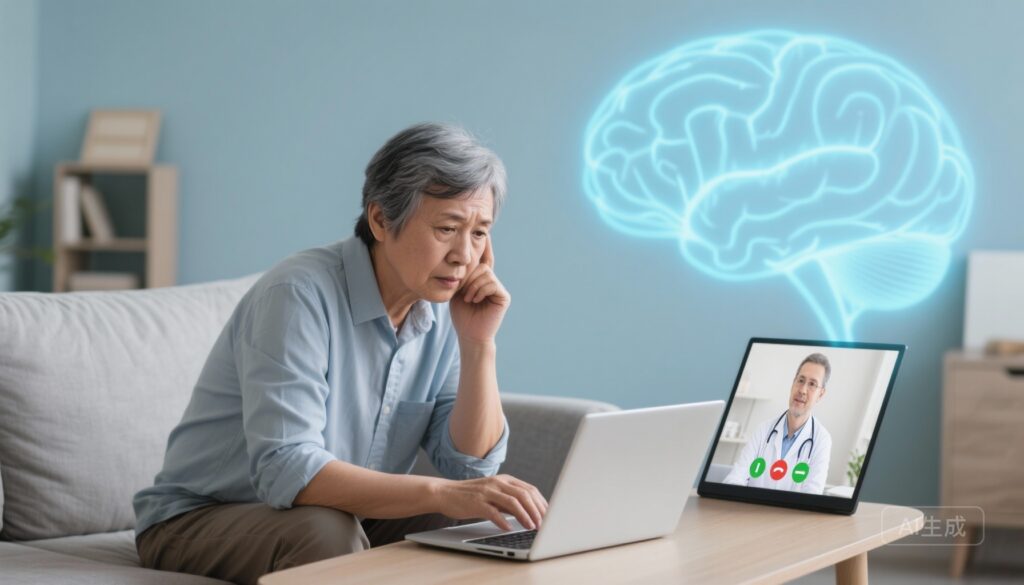Highlight
– A 5‑arm, multicenter randomized clinical trial (RECOVER‑NEURO) of remotely delivered interventions for cognitive symptoms in long COVID found no differential benefit on the primary outcome (modified Everyday Cognition Scale 2) for adaptive computerized cognitive training, a structured cognitive‑behavioral rehabilitation program, or transcranial direct current stimulation (tDCS) paired with training.
– All five arms—including active comparators and sham controls—showed modest within‑group improvements over time, but between‑group adjusted differences were null with narrow confidence intervals.
– Interventions were safe with no serious adverse events attributable to treatment; the trial highlights challenges in treating subjective cognitive complaints after COVID‑19 and informs priorities for future mechanistic and pragmatic trials.
Background: clinical context and unmet need
Persistent cognitive complaints—commonly described as “brain fog,” problems with attention, processing speed, memory, and executive function—are a central component of the post‑acute sequelae of SARS‑CoV‑2 infection (PASC or “long COVID”). These symptoms can persist for months and have substantial functional consequences for work, daily activities, and quality of life. Despite the high prevalence of cognitive sequelae, evidence‑based treatments remain limited and represent a major unmet need for clinicians and patients.
Multiple therapeutic strategies have been proposed, including computerized cognitive training platforms that target attention and processing speed, structured cognitive rehabilitation programs adapted from stroke and traumatic brain injury paradigms, and neuromodulation techniques such as transcranial direct current stimulation (tDCS). Prior data for these approaches come largely from heterogeneous populations (older adults, mild cognitive impairment, neurologic rehabilitation), and their applicability to long COVID is uncertain. Well‑designed randomized trials are therefore essential to establish efficacy and safety in this population.
Study design
The RECOVER‑NEURO phase 2 trial was a 5‑arm, multicenter randomized clinical trial conducted at 22 sites between August 17, 2023, and June 10, 2024. The study screened 378 individuals and enrolled 328 participants with cognitive symptoms attributed to long COVID. Median age was 48 years (IQR 37–58); 73.5% were female; race and ethnicity distribution included 71.6% White, 14.3% Black, 4.6% Asian, and 15.9% Hispanic participants.
Interventions were delivered remotely five times per week for 10 weeks. Participants were randomized to one of five arms:
- Adaptive computerized cognitive training (BrainHQ, Posit Science).
- Structured cognitive‑behavioral rehabilitation (PASC‑Cognitive Recovery, PASC‑CoRE) combined with BrainHQ.
- Active tDCS paired with BrainHQ (tDCS‑active + BrainHQ).
- Active comparator: unstructured computer puzzles and games.
- Sham tDCS paired with BrainHQ (tDCS‑sham + BrainHQ).
Assessments were in‑person at baseline, midintervention, end of intervention (primary endpoint), and 3 months post‑intervention. The prespecified primary outcome was participant‑reported function on the modified Everyday Cognition Scale 2 (ECog2), comparing end‑of‑intervention to baseline and referencing the prior 7‑day period. Secondary outcomes included other participant‑reported measures and objective neuropsychological tests. Safety and adverse events were monitored throughout.
Key findings
None of the three active interventions produced a statistically or clinically significant benefit on the primary outcome (modified ECog2) in the intention‑to‑treat population at the end of the 10‑week intervention period.
Reported adjusted differences in mean change (active treatment vs comparator) with 95% confidence intervals were as follows:
- BrainHQ vs active comparator (unstructured computer games): 0.0 (95% CI, −0.2 to 0.2).
- PASC‑CoRE + BrainHQ vs active comparator: 0.1 (95% CI, −0.1 to 0.3).
- tDCS‑active + BrainHQ vs tDCS‑sham + BrainHQ: 0.0 (95% CI, −0.2 to 0.2).
- PASC‑CoRE + BrainHQ vs BrainHQ alone: 0.1 (95% CI, −0.1 to 0.3).
Secondary participant‑reported outcomes and objective neuropsychological tests likewise showed no differential benefits across treatment arms. Importantly, all five arms demonstrated some degree of within‑group improvement on the modified ECog2 and on several secondary measures over time; however, these changes did not differ between active and comparator or sham arms.
Safety: there were no serious adverse events attributable to the interventions. Remotely delivered BrainHQ training, structured rehabilitation sessions, and tDCS (active and sham) were generally well tolerated in this outpatient cohort.
Interpretation of the effect estimates
The precision of the reported confidence intervals—straddling the null and relatively narrow—suggests that large treatment effects are unlikely for these specific interventions, as delivered in this trial. The convergence of null between‑group differences with observable within‑group improvements points to non‑specific effects such as regression to the mean, natural recovery over time, placebo/contextual effects, or benefits related to engagement and attention from participating in a structured program rather than to specific active components of the interventions.
Expert commentary: strengths, limitations, and implications
Strengths of the trial include its randomized, multicenter design; the inclusion of multiple active and sham comparator arms; remote delivery that enhances real‑world relevance; prespecified participant‑reported primary outcome; diversity across sites; and rigorous in‑person neuropsychological assessments.
Limitations to consider when applying these findings to broader clinical practice:
- Population and symptom heterogeneity: Long COVID is a heterogeneous syndrome with multiple potential mechanisms (inflammation, microvascular injury, autonomic dysfunction, deconditioning, mood and sleep disturbances). A heterogeneous trial sample may dilute signals of benefit if specific subgroups are responsive to an intervention.
- Phenotype and endpoint selection: The primary outcome relied on short‑term (7‑day) self‑report at 10 weeks. Although patient‑reported outcomes are clinically meaningful, they may be influenced by expectations, mood, or non‑specific factors. Objective neuropsychological testing did not demonstrate benefits either, but test batteries have limited sensitivity to subtle changes across diverse cognitive domains impacted in long COVID.
- Dose and mode of delivery: The interventions were fully remote and self‑administered at high frequency (5×/week). Different dosing, longer‑term supervised rehabilitation, hybrid in‑person models, or multimodal interventions (sleep, graded exercise, pharmacologic therapies) might yield different results.
- Timing relative to illness: The median time since acute infection and duration of cognitive symptoms were not highlighted in the summary. Treatment effects could vary by chronicity; early or late interventions may perform differently.
- Expectancy and control arm choice: The active comparator (unstructured computer games) may have provided cognitive engagement, social contact (in some arms), and behavioral activation that contributed to improvement, reducing the observed difference between arms.
Mechanistic implications: The null findings do not rule out the possibility that specific rehabilitation approaches or neuromodulation paradigms could benefit well‑defined subgroups of patients with long COVID. They do, however, temper enthusiasm for broad implementation of these interventions as currently delivered and underscore the need for targeted mechanistic studies to identify biosignatures or clinical phenotypes most likely to respond.
Clinical and research takeaways
For clinicians: at present, there is no high‑quality randomized evidence from this trial to support routine prescription of adaptive BrainHQ training, the PASC‑CoRE structured cognitive rehabilitation program, or tDCS (as configured in this study) specifically to improve self‑reported cognitive symptoms in unselected patients with long COVID. Symptomatic management, attention to comorbid contributors (sleep, mood, pain, medication effects), functional supports, and shared decision‑making remain essential.
For researchers and funders: future trials should consider stratifying by biologic or clinical phenotypes, incorporating mechanistic biomarkers (neuroimaging, inflammatory markers, autonomic testing), testing combined multimodal approaches, and exploring different dosing/supervision models. Trials powered for subgroup analyses, longer follow‑up, and pragmatic effectiveness designs will be particularly informative.
Conclusion
This rigorously conducted phase 2 randomized trial failed to demonstrate that adaptive computerized cognitive training, a structured cognitive‑behavioral rehabilitation program, or tDCS delivered remotely provided differential benefit over active or sham comparators for self‑reported cognitive symptoms in long COVID. The safety profile was acceptable. The findings emphasize the complexity of cognitive sequelae after SARS‑CoV‑2 infection and the need for mechanistically informed, targeted therapeutic research rather than broad application of cognitive training or neuromodulation in unselected long COVID populations.
Funding and trial registration
Trial registration: ClinicalTrials.gov Identifier: NCT05965739.
Funding: See the primary publication for detailed funding and conflict of interest disclosures. The trial was conducted by the RECOVER‑NEURO Clinical Trial Group; full author and funding statements are available in the JAMA Neurology publication cited below.
Reference
Knopman DS, Koltai D, Laskowitz D, et al; RECOVER‑NEURO Clinical Trial Group. Evaluation of Interventions for Cognitive Symptoms in Long COVID: A Randomized Clinical Trial. JAMA Neurol. 2025 Nov 10:e254415. doi:10.1001/jamaneurol.2025.4415. PMID: 41212544; PMCID: PMC12603944.
Selected background references:
- Nalbandian A, Sehgal K, Gupta A, et al. Post‑acute COVID‑19 syndrome. Nat Med. 2021;27(4):601–615.
- Groff D, Sun A, Ssentongo AE, et al. Short‑term and long‑term rates of post‑acute sequelae of SARS‑CoV‑2 infection: a systematic review. JAMA Netw Open. 2021;4(10):e2128568.
- World Health Organization. A clinical case definition of post COVID‑19 condition by a Delphi consensus, 6 October 2021. WHO; 2021.



